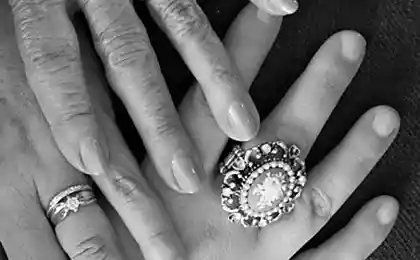783
A new look at SCENARIO message from parent to child
Chapter from the book by J. Stewart, B. Dzhoynsa "life scenarios»
Life script consists of a series of decisions. These decisions are made by the child in response to the scenario messages about themselves, others and the world in general. Scenario messages originate mainly from the child's parents.
In this chapter, we consider the nature of the scenario of messages and methods of transmission. We will get acquainted with the model of "Matrix Script", which is a standard method for analyzing the messages that underlie any scenario.
SCENARIO AND ADDRESS OF PERCEPTION infant
It is important to remember that the decisions taken by the child scenario - is it a response to their own perception of what is happening in the outside world. Meanwhile, due to the perception of the infant infant features of the emotional sphere and the peculiarities of infant test their perceptions of reality to match.
Consequently, the perceived infant messages that come from the parents and the outside world may be very different from the same messages perceived to adults. Not being able to speak, afraid unexpected loud sound of a child can draw a conclusion: "Someone out there is trying to kill me!" In fact, the parents are happy that what they have created a cozy atmosphere of his beloved little one
. TYPES OF MESSAGES Scenario
Scenario messages can be transmitted verbally, non-verbally, or these two ways at the same time.
Both verbal and nonverbal messages may include an element of role models.
Verbal messages can be transmitted in the form of guidelines or evaluation definitions.
Verbal and non-verbal messages

Before the baby begins to capture the content of the words, he interprets the messages of others on the basis of non-verbal signals, which are accompanied by these messages. Small child subtly perceive facial expressions, body tension, movement, tone of voice and smells.
If Mom gently presses to her child, providing him with his body as a support, it is likely to accept its message as "I accept you and love you!" If she is tense and tightly holding him as if about himself, he can read her message anyway "I reject you, and I do not want you to touch me!" The mother in this case may be quite unaware of either its voltage or the gap between themselves and the child
. Sometimes a child can retrieve messages from the scenic surrounding events not associated with parents. Loud noises, sudden movements, separation from parents during their stay in hospital - all this may seem a threat to a child's life. Because he believes that parents manage what is happening, it can come to the conclusion that these threats also come from them.
Later, when the child begins to understand speech, non-verbal signals will still continue to be important components for it scenic messages. Physical punishment or the threat thereof, may mean to the child that the parent rejects it or perhaps wished his death. When speaking of parents with a child, it will interpret the meaning of the above scenario, in accordance with the accompanying non-verbal signals. Recall the third rule of communication Bern: in the case of hidden transaction message is transmitted to the significant psychological level
. Imagine a first-grader who comes home from school with just received from the teacher of a new book for home reading. She begins to read her parents and stumbles upon an unfamiliar word. Father says: "The word you read is not true." This phrase may be accompanied by very different sets of non-verbal signals. Each of them would have a different meaning for the child in terms of the possible scenario solutions.
Father can say rude loud voice, twisting his lips and complained grimacing. He can knock out a book from the hands of his daughter or give her a cuff. For the child, such a message means: "I do not want to see you, I wish you'd died»
. He could say the phrase indifferent voice said, not looking up from the newspaper. Considers these non-verbal signals, it interprets it as a message: "You are to me of no interest»
. He may be accompanied by the words chuckle and a wink. Applying the strategy of the Little Professor, the girl can try to giggle in response. Similarly, Pope smiled even wider. She understood his message: "Do you want me to like, play the fool»
. Father would say this phrase in an even voice, sitting next to her and pointing to corresponding word finger. Then he would give her time to get back to that word and read it again. In this case, the "Martian" the father tells the child:. "When do you think - it's good»
Imitation

Young children are closely watching how other people behave. Especially, they say, how to communicate between a father and mother, as well as how they relate to other family members. By using strategies Professor Little child is constantly trying to get an answer to the question: "How can I best achieve what I want»
Perhaps the little girl says that if Mom wants something from the Pope, then to get his first she picks a quarrel, and then crying. The child makes for a conclusion: "To get away from people, especially men, what I want, I need to first quarrel with them, and then burst into tears»
. For example, the little boy had a brother who died. He pointed out that his parents are flowers in the cemetery every week. They have almost all the time and kind of sad, they seem to think more about her son, who had died, than that which is still alive. The child concludes: "All the attention goes to the dead." He still does not understand, like an adult, death - this is the end. Therefore, it may decide: "To the parents were attentive to me the way I want, I have to die, as did my brother»
. Guidance and evaluation determining
Scenario message can take the form of direct instruction: "Do not bother! Do what you're told! The march out of here! Hurry! Do not be fancy! If the first time did not work, try another, and another, and another! "Most parents fall asleep their children hundreds of such indications. Scenario potential of this kind of messages will depend on the frequency of recurrence and associated non-verbal signals.
In other cases, they can not tell the child he has to do, and what it represents. Such messages are called evaluative definitions:
"Goonies!»
"You're my little girl!»
"You'll end up in prison.»
"You can not do it.»
"You read well!».
All these are examples of definitions of evaluation, reported directly to the child. Their content can be positive or negative. Their potential scenario, as in all other cases, depending on the accompanying non-verbal signals. Very pronounced and accompanied by a slap estimated definition of "Goonies!" Scenario sends a message other than the same determination, spoken calmly, with a smile and a gentle pat on the shoulder.
Sometimes estimates definitions may be given indirectly. This happens in cases where the parent is talking to someone about your child in his presence, or when the child later learns of such a conversation.
"This is a quiet child.»
"Jill's so smart!»
"You know, he is weak boy.»
"We are concerned that she is spoiled.»
"My father says that is not from plaguing you.»
It is this kind of indirect estimates of determination often perceived by the child as the strong message of the scenario. Parents in his eyes govern reality. And when the child hears them tell other people what he is, he takes their words at face value, believing that the way it is.
In some families, the estimated definitions are passed from generation to generation by means of messages on the psychological level. The latter may be based on attributes such as the name of the child or his family situation.
For example, Ellen turned to a therapist with complaints about the fear of going insane. Through the analysis of his script, she noted that her family were two women, named Ellen: aunt and grandmother. Both are clouded reason about the age of Ellen. Message on a psychological level, which is never uttered aloud, read: "In our family everyone name is Ellen, going crazy in 35 years.»
Traumatic events and repetitive messages
The child can take the main scenario the decision in response to a single event in which he sees a particular threat. For example, a little girl was the victim of sexual abuse by her father. She can perceive this episode as a single heavy-duty scenario message and decide, "I'll never trust men»
. The period of separation from the mother in early childhood is often the reason for the non-verbal solutions such as: "I can not trust anybody," or "People want me to die." Some therapists believe that a strong influence on the child's scenic solutions and provides a single traumatic event, his appearance on the light.
However, most scenic decisions immediately, but after a certain period, in response to some constantly repeated message. For example, the baby reaches out to Mom, and she turns away from him. He reaches again and again finds no reciprocity. Only after this is repeated many times, it can come to a conclusion: "My mother did not want me to touch her»
. A little boy who heard the definition of "child is shy," you may need to hear this phrase over and over again for months and years before he firmly decides that he really shy.
Eric Berne comparing similar scenario accumulation of messages with the folding coins in a column. Several coins in the column are uneven. The more coins, the more likely that the column would fall. It can ruin a coin an awkward position. It can destroy several slightly shifted coins, especially if they are shifted in one direction from the center of gravity. This is a graphic illustration of how the combination of traumatic events and repetitive messages creates the basis for life scenario.
MATRIX SCENARIO
Have your mother and father were also state Parent, Adult and Child. They sent you a message from the scenario of these three states Ya Taking this message to you, "hemming" him to some of their own states J. Accordingly, Claude Steiner has developed one of the most important models SLT-matrix script.
< br> The messages coming from the state of the parents father and mother, called prescriptions ( "kontrzapretami") and form part of the content of your Parent.
Lessons by imitating parents or messages Adult messages "how", addressed to adult parents of adult children, form the program.
The messages coming from the state of the child's father and mother, can be of two types: restrictive and permissive. They are part of the content of your child's condition.
Matrix schemes script by various authors differ in small details. Above is a summary version of it.
Regulations ( "kontrzaprety»)
Initially, these messages from Parent to Parent were called "counter-ban" as it was believed that they "run counter" to the latter. At present, we know that sometimes these messages can indeed be contrary to the prohibitions, but just as often, and can support them or do not have to do with them. Nevertheless, the original term caught on and is still used today.
Kontrstsenary is a set of decisions taken by the child in accordance with kontrzapretami or, quite simply, the regulations. Regulations consist of guidance on what to do or not to do, and judgments about people and the world at large. All we receive thousands of such requirements from the parents and parental figures. Here are a few typical requirements:
"Behave yourself!»
"Do not be fancy!»
"Be a good girl!»
"Many work!»
"You've got to be the best in class!»
"Lying is bad.»
"Do not wash dirty linen in public.»
We use our kontrstsenary mostly in a positive way, making it easier to use it to their lives and well fitting into society. Adults we do not need to think, to be decently belch at the table or throw crumbs over his shoulder; knowledge about this already inherent in our positive kontrstsenarii. Similarly, we do not run across the road in front of oncoming traffic and Sui hands in the fire.
However, most of us have several kontrstsenarnyh messages that we have decided to use in the composition of the negative script. Suppose, in the mind of my spinning Parent injunction: "A lot of work!" I could follow it in order to succeed in school and college. I can continue to work hard and in their professional field and reached thanks to this high position.
However, due to this prescription, I can also "burn out on the job." For work, I would sacrifice holidays, health and friends. If I have a fatal scenario, I can use the instruction "a lot of work" for the approximation of decoupling in the form of stomach ulcers, high blood pressure or a heart attack.
There are five requirements that play a special role in kontrstsenarii. Here they are:
Be the Perfect / Perfect;
Be Strong / Strong;
Tries hard;
Like (other);
Hurry.
They are called the policy messages, or simply directives (lit. "drivers", "what is." - Approx lane..). The term "directive" is used because the child feels the urgent need to follow these regulations. He believes that is guided by the directive, it OK.
These five letters are included in kontrstsenary each person, but in different proportions. When I listen to the internal directive message, I involuntarily shows a typical set of behaviors prescribed by the Directive. The corresponding five forms of decision-making behavior of all people are the same. By studying the behavioral manifestations of human decision-making, we can confidently predict some important features of his script.
Program
The program consists of messages on how to do this or that. When completing the matrix scenario we begin the message with the words "here's how ..." Each of us has learned thousands of policy messages from parents and parental figures. For example, "Here's how ...
count to 10;
written your name;
make porridge;
tie shoelaces;
behaves a man (woman);
like;
to become the first student in the class;
to hide their feelings. »
As kontrstsenariya, most of our software we use letters in a constructive, positive way. However, we can also bear a negative any program. For example, a boy may learn, in imitation of my father, "how to work hard, overstrain and die young." Little girl can learn from the mother, "it does not give way to feelings and live the rest of his days in a deep depression.»
In the scheme of the matrix, these adverse programs could be more accurately represented as messages that originate from an infected adult parents and imprinted in the infected adult child. Many of the messages of "how" and it would be better considered as the content of the Little Professor (B1) parent, which is embodied in the B1, B2, and not the child. But such details on the scheme are not normally specified.
The prohibitions and permissions
Imagine a mother and her newborn child. Looking after him, she can play the message, captured in its parent state, for example: "Children need to be protected. The child in anything does not need. " Most of the time it can be in an adult, following the methods of care for a child, which she read in books. But what happens to her child's condition?
When the mother returns to the past and remembers her childhood, she might be a feeling of "This is great! There was another kid, and you can play with it! "Exchanging strokes with a child, she can experience joy similar to that experienced in the exchange of strokes in childhood. Catching her non-verbal messages, the baby can conclude: "Mom wants me and she likes that I touch her.»
In the language of the script, the mother gives her baby authorization - in this case, the resolution also exist permission to touch
. But the mother can feel the baby and something else: "It is dangerous. There is a new kid, and now he is sure to be the center of attention. And if I need it? Will all the attention? "Reproducing these uncensored feelings and needs of the times of their own infancy, the mother may be frightened by the appearance of a newborn, and to be angry with him. In the depths of their child's condition, it may want to get rid of the baby, or even kill him.
Скорее всего, она совершенно не будет сознавать этих чувств. В своем сознании и с точки зрения любого внешнего наблюдателя она будет любящей и заботливой матерью.
Но младенец читает ее чувства, как открытую книгу. Тонко различая невербальные сигналы, он улавливает страх и гнев Мамы. Со временем он может прийти к выводу: «Мама не хочет, чтобы я к ней прикасался. На самом деле она хочет, чтобы меня и близко не было».
Эти отрицательные послания, исходящие от Ребенка родителя, служат примерами запретов. В данном случае мы имеем запрет на существование и запрет на прикосновение («не существуй» и «не прикасайся»).
Будучи взрослым, каждый из нас несет в себе определенный набор запретов и разрешений, запечатленных в нашем состоянии Ребенка. Решения, которые мы принимаем в ответ на эти послания, служат основной составляющей фундамента нашего жизненного сценария. Весь этот комплекс из запретов и разрешений в сочетании с принятыми на их основе ранними решениями иногда называют собственно сценарием.
Отличие запрещений/разрешений от предписаний
Как на практике отличить отрицательное предписание от запрета? Или положительное предписание от разрешения? Они различаются в двух отношениях.
Предписания имеют вербальную природу, тогда как запрещения/разрешения (первоначально) довербальны. Если вы прислушаетесь к тому, что происходит у вас в голове, то сможете услышать ваши предписания, произносимые в форме слов. Нередко вы сможете услышать даже, кто именно из родителей или родительских фигур произнес их вам впервые.
Если вы поступите вопреки предписанию и вновь прислушаетесь, то скорее всего услышите вербальную взбучку от соответствующей родительской фигуры.
Напротив, запреты и разрешения не обязательно слышатся в форме слов. Вы воспринимаете их в форме эмоций и телесных ощущений, которые отражаются затем на вашем поведении.
Если вы поступите вопреки запрету, то скорее всего почувствуете физическое напряжение или дискомфорт. Например, у вас может начаться сердцебиение, вы можете покрыться испариной, или у вас засосет под ложечкой. Как правило, вы находите любые поводы, чтобы избежать поведения, нарушающего запрет. Эти поводы могут казаться вам Взрослыми, но на самом деле представляют собой рационализацию.
Допустим, к примеру, младенцем я усвоил от матери запрет «не прикасайся», и принял решение, что от людей лучше держаться подальше. Теперь, уже будучи взрослым, я принимаю участие в инкаунтер-группе. Ведущий предлагает нам закрыть глаза, найти на ощупь какого-нибудь партнера, и узнать, что это за человек, исследуя ощупью его руку. Я покрываюсь легкой испариной и мой пульс учащается. Почувствовав, что кто-то коснулся моей руки, я открываю глаза и говорю: «Хм. Не вижу смысла в этом упражнении. Для чего оно нужно, как вы думаете?»
Иногда запреты также можно услышать в форме слов. Например, человек, усвоивший запрет «не существуй», может вспомнить, как родители говорили ему нечто вроде «И зачем ты только на свет появился!» или «Чтоб ты сдох!»
Запрещения/разрешения даются в раннем детстве, а предписания позже. Запрещения/разрешения относятся к более ранней стадии развития ребенка, чем предписания. Именно с этим связано их различие как «вербального и довербального». Запрещения и разрешения ребенок усваивает в основном до того, как начинает говорить. Точно указать конечную границу этого периода нельзя. Мы нашли, что запреты продолжают восприниматься вплоть шести-восьми лет. Предписания усваиваются в возрасте от трех до двенадцати лет.
Life script consists of a series of decisions. These decisions are made by the child in response to the scenario messages about themselves, others and the world in general. Scenario messages originate mainly from the child's parents.
In this chapter, we consider the nature of the scenario of messages and methods of transmission. We will get acquainted with the model of "Matrix Script", which is a standard method for analyzing the messages that underlie any scenario.
SCENARIO AND ADDRESS OF PERCEPTION infant
It is important to remember that the decisions taken by the child scenario - is it a response to their own perception of what is happening in the outside world. Meanwhile, due to the perception of the infant infant features of the emotional sphere and the peculiarities of infant test their perceptions of reality to match.
Consequently, the perceived infant messages that come from the parents and the outside world may be very different from the same messages perceived to adults. Not being able to speak, afraid unexpected loud sound of a child can draw a conclusion: "Someone out there is trying to kill me!" In fact, the parents are happy that what they have created a cozy atmosphere of his beloved little one
. TYPES OF MESSAGES Scenario
Scenario messages can be transmitted verbally, non-verbally, or these two ways at the same time.
Both verbal and nonverbal messages may include an element of role models.
Verbal messages can be transmitted in the form of guidelines or evaluation definitions.
Verbal and non-verbal messages

Before the baby begins to capture the content of the words, he interprets the messages of others on the basis of non-verbal signals, which are accompanied by these messages. Small child subtly perceive facial expressions, body tension, movement, tone of voice and smells.
If Mom gently presses to her child, providing him with his body as a support, it is likely to accept its message as "I accept you and love you!" If she is tense and tightly holding him as if about himself, he can read her message anyway "I reject you, and I do not want you to touch me!" The mother in this case may be quite unaware of either its voltage or the gap between themselves and the child
. Sometimes a child can retrieve messages from the scenic surrounding events not associated with parents. Loud noises, sudden movements, separation from parents during their stay in hospital - all this may seem a threat to a child's life. Because he believes that parents manage what is happening, it can come to the conclusion that these threats also come from them.
Later, when the child begins to understand speech, non-verbal signals will still continue to be important components for it scenic messages. Physical punishment or the threat thereof, may mean to the child that the parent rejects it or perhaps wished his death. When speaking of parents with a child, it will interpret the meaning of the above scenario, in accordance with the accompanying non-verbal signals. Recall the third rule of communication Bern: in the case of hidden transaction message is transmitted to the significant psychological level
. Imagine a first-grader who comes home from school with just received from the teacher of a new book for home reading. She begins to read her parents and stumbles upon an unfamiliar word. Father says: "The word you read is not true." This phrase may be accompanied by very different sets of non-verbal signals. Each of them would have a different meaning for the child in terms of the possible scenario solutions.
Father can say rude loud voice, twisting his lips and complained grimacing. He can knock out a book from the hands of his daughter or give her a cuff. For the child, such a message means: "I do not want to see you, I wish you'd died»
. He could say the phrase indifferent voice said, not looking up from the newspaper. Considers these non-verbal signals, it interprets it as a message: "You are to me of no interest»
. He may be accompanied by the words chuckle and a wink. Applying the strategy of the Little Professor, the girl can try to giggle in response. Similarly, Pope smiled even wider. She understood his message: "Do you want me to like, play the fool»
. Father would say this phrase in an even voice, sitting next to her and pointing to corresponding word finger. Then he would give her time to get back to that word and read it again. In this case, the "Martian" the father tells the child:. "When do you think - it's good»
Imitation

Young children are closely watching how other people behave. Especially, they say, how to communicate between a father and mother, as well as how they relate to other family members. By using strategies Professor Little child is constantly trying to get an answer to the question: "How can I best achieve what I want»
Perhaps the little girl says that if Mom wants something from the Pope, then to get his first she picks a quarrel, and then crying. The child makes for a conclusion: "To get away from people, especially men, what I want, I need to first quarrel with them, and then burst into tears»
. For example, the little boy had a brother who died. He pointed out that his parents are flowers in the cemetery every week. They have almost all the time and kind of sad, they seem to think more about her son, who had died, than that which is still alive. The child concludes: "All the attention goes to the dead." He still does not understand, like an adult, death - this is the end. Therefore, it may decide: "To the parents were attentive to me the way I want, I have to die, as did my brother»
. Guidance and evaluation determining
Scenario message can take the form of direct instruction: "Do not bother! Do what you're told! The march out of here! Hurry! Do not be fancy! If the first time did not work, try another, and another, and another! "Most parents fall asleep their children hundreds of such indications. Scenario potential of this kind of messages will depend on the frequency of recurrence and associated non-verbal signals.
In other cases, they can not tell the child he has to do, and what it represents. Such messages are called evaluative definitions:
"Goonies!»
"You're my little girl!»
"You'll end up in prison.»
"You can not do it.»
"You read well!».
All these are examples of definitions of evaluation, reported directly to the child. Their content can be positive or negative. Their potential scenario, as in all other cases, depending on the accompanying non-verbal signals. Very pronounced and accompanied by a slap estimated definition of "Goonies!" Scenario sends a message other than the same determination, spoken calmly, with a smile and a gentle pat on the shoulder.
Sometimes estimates definitions may be given indirectly. This happens in cases where the parent is talking to someone about your child in his presence, or when the child later learns of such a conversation.
"This is a quiet child.»
"Jill's so smart!»
"You know, he is weak boy.»
"We are concerned that she is spoiled.»
"My father says that is not from plaguing you.»
It is this kind of indirect estimates of determination often perceived by the child as the strong message of the scenario. Parents in his eyes govern reality. And when the child hears them tell other people what he is, he takes their words at face value, believing that the way it is.
In some families, the estimated definitions are passed from generation to generation by means of messages on the psychological level. The latter may be based on attributes such as the name of the child or his family situation.
For example, Ellen turned to a therapist with complaints about the fear of going insane. Through the analysis of his script, she noted that her family were two women, named Ellen: aunt and grandmother. Both are clouded reason about the age of Ellen. Message on a psychological level, which is never uttered aloud, read: "In our family everyone name is Ellen, going crazy in 35 years.»
Traumatic events and repetitive messages
The child can take the main scenario the decision in response to a single event in which he sees a particular threat. For example, a little girl was the victim of sexual abuse by her father. She can perceive this episode as a single heavy-duty scenario message and decide, "I'll never trust men»
. The period of separation from the mother in early childhood is often the reason for the non-verbal solutions such as: "I can not trust anybody," or "People want me to die." Some therapists believe that a strong influence on the child's scenic solutions and provides a single traumatic event, his appearance on the light.
However, most scenic decisions immediately, but after a certain period, in response to some constantly repeated message. For example, the baby reaches out to Mom, and she turns away from him. He reaches again and again finds no reciprocity. Only after this is repeated many times, it can come to a conclusion: "My mother did not want me to touch her»
. A little boy who heard the definition of "child is shy," you may need to hear this phrase over and over again for months and years before he firmly decides that he really shy.
Eric Berne comparing similar scenario accumulation of messages with the folding coins in a column. Several coins in the column are uneven. The more coins, the more likely that the column would fall. It can ruin a coin an awkward position. It can destroy several slightly shifted coins, especially if they are shifted in one direction from the center of gravity. This is a graphic illustration of how the combination of traumatic events and repetitive messages creates the basis for life scenario.
MATRIX SCENARIO
Have your mother and father were also state Parent, Adult and Child. They sent you a message from the scenario of these three states Ya Taking this message to you, "hemming" him to some of their own states J. Accordingly, Claude Steiner has developed one of the most important models SLT-matrix script.
< br> The messages coming from the state of the parents father and mother, called prescriptions ( "kontrzapretami") and form part of the content of your Parent.
Lessons by imitating parents or messages Adult messages "how", addressed to adult parents of adult children, form the program.
The messages coming from the state of the child's father and mother, can be of two types: restrictive and permissive. They are part of the content of your child's condition.
Matrix schemes script by various authors differ in small details. Above is a summary version of it.
Regulations ( "kontrzaprety»)
Initially, these messages from Parent to Parent were called "counter-ban" as it was believed that they "run counter" to the latter. At present, we know that sometimes these messages can indeed be contrary to the prohibitions, but just as often, and can support them or do not have to do with them. Nevertheless, the original term caught on and is still used today.
Kontrstsenary is a set of decisions taken by the child in accordance with kontrzapretami or, quite simply, the regulations. Regulations consist of guidance on what to do or not to do, and judgments about people and the world at large. All we receive thousands of such requirements from the parents and parental figures. Here are a few typical requirements:
"Behave yourself!»
"Do not be fancy!»
"Be a good girl!»
"Many work!»
"You've got to be the best in class!»
"Lying is bad.»
"Do not wash dirty linen in public.»
We use our kontrstsenary mostly in a positive way, making it easier to use it to their lives and well fitting into society. Adults we do not need to think, to be decently belch at the table or throw crumbs over his shoulder; knowledge about this already inherent in our positive kontrstsenarii. Similarly, we do not run across the road in front of oncoming traffic and Sui hands in the fire.
However, most of us have several kontrstsenarnyh messages that we have decided to use in the composition of the negative script. Suppose, in the mind of my spinning Parent injunction: "A lot of work!" I could follow it in order to succeed in school and college. I can continue to work hard and in their professional field and reached thanks to this high position.
However, due to this prescription, I can also "burn out on the job." For work, I would sacrifice holidays, health and friends. If I have a fatal scenario, I can use the instruction "a lot of work" for the approximation of decoupling in the form of stomach ulcers, high blood pressure or a heart attack.
There are five requirements that play a special role in kontrstsenarii. Here they are:
Be the Perfect / Perfect;
Be Strong / Strong;
Tries hard;
Like (other);
Hurry.
They are called the policy messages, or simply directives (lit. "drivers", "what is." - Approx lane..). The term "directive" is used because the child feels the urgent need to follow these regulations. He believes that is guided by the directive, it OK.
These five letters are included in kontrstsenary each person, but in different proportions. When I listen to the internal directive message, I involuntarily shows a typical set of behaviors prescribed by the Directive. The corresponding five forms of decision-making behavior of all people are the same. By studying the behavioral manifestations of human decision-making, we can confidently predict some important features of his script.
Program
The program consists of messages on how to do this or that. When completing the matrix scenario we begin the message with the words "here's how ..." Each of us has learned thousands of policy messages from parents and parental figures. For example, "Here's how ...
count to 10;
written your name;
make porridge;
tie shoelaces;
behaves a man (woman);
like;
to become the first student in the class;
to hide their feelings. »
As kontrstsenariya, most of our software we use letters in a constructive, positive way. However, we can also bear a negative any program. For example, a boy may learn, in imitation of my father, "how to work hard, overstrain and die young." Little girl can learn from the mother, "it does not give way to feelings and live the rest of his days in a deep depression.»
In the scheme of the matrix, these adverse programs could be more accurately represented as messages that originate from an infected adult parents and imprinted in the infected adult child. Many of the messages of "how" and it would be better considered as the content of the Little Professor (B1) parent, which is embodied in the B1, B2, and not the child. But such details on the scheme are not normally specified.
The prohibitions and permissions
Imagine a mother and her newborn child. Looking after him, she can play the message, captured in its parent state, for example: "Children need to be protected. The child in anything does not need. " Most of the time it can be in an adult, following the methods of care for a child, which she read in books. But what happens to her child's condition?
When the mother returns to the past and remembers her childhood, she might be a feeling of "This is great! There was another kid, and you can play with it! "Exchanging strokes with a child, she can experience joy similar to that experienced in the exchange of strokes in childhood. Catching her non-verbal messages, the baby can conclude: "Mom wants me and she likes that I touch her.»
In the language of the script, the mother gives her baby authorization - in this case, the resolution also exist permission to touch
. But the mother can feel the baby and something else: "It is dangerous. There is a new kid, and now he is sure to be the center of attention. And if I need it? Will all the attention? "Reproducing these uncensored feelings and needs of the times of their own infancy, the mother may be frightened by the appearance of a newborn, and to be angry with him. In the depths of their child's condition, it may want to get rid of the baby, or even kill him.
Скорее всего, она совершенно не будет сознавать этих чувств. В своем сознании и с точки зрения любого внешнего наблюдателя она будет любящей и заботливой матерью.
Но младенец читает ее чувства, как открытую книгу. Тонко различая невербальные сигналы, он улавливает страх и гнев Мамы. Со временем он может прийти к выводу: «Мама не хочет, чтобы я к ней прикасался. На самом деле она хочет, чтобы меня и близко не было».
Эти отрицательные послания, исходящие от Ребенка родителя, служат примерами запретов. В данном случае мы имеем запрет на существование и запрет на прикосновение («не существуй» и «не прикасайся»).
Будучи взрослым, каждый из нас несет в себе определенный набор запретов и разрешений, запечатленных в нашем состоянии Ребенка. Решения, которые мы принимаем в ответ на эти послания, служат основной составляющей фундамента нашего жизненного сценария. Весь этот комплекс из запретов и разрешений в сочетании с принятыми на их основе ранними решениями иногда называют собственно сценарием.
Отличие запрещений/разрешений от предписаний
Как на практике отличить отрицательное предписание от запрета? Или положительное предписание от разрешения? Они различаются в двух отношениях.
Предписания имеют вербальную природу, тогда как запрещения/разрешения (первоначально) довербальны. Если вы прислушаетесь к тому, что происходит у вас в голове, то сможете услышать ваши предписания, произносимые в форме слов. Нередко вы сможете услышать даже, кто именно из родителей или родительских фигур произнес их вам впервые.
Если вы поступите вопреки предписанию и вновь прислушаетесь, то скорее всего услышите вербальную взбучку от соответствующей родительской фигуры.
Напротив, запреты и разрешения не обязательно слышатся в форме слов. Вы воспринимаете их в форме эмоций и телесных ощущений, которые отражаются затем на вашем поведении.
Если вы поступите вопреки запрету, то скорее всего почувствуете физическое напряжение или дискомфорт. Например, у вас может начаться сердцебиение, вы можете покрыться испариной, или у вас засосет под ложечкой. Как правило, вы находите любые поводы, чтобы избежать поведения, нарушающего запрет. Эти поводы могут казаться вам Взрослыми, но на самом деле представляют собой рационализацию.
Допустим, к примеру, младенцем я усвоил от матери запрет «не прикасайся», и принял решение, что от людей лучше держаться подальше. Теперь, уже будучи взрослым, я принимаю участие в инкаунтер-группе. Ведущий предлагает нам закрыть глаза, найти на ощупь какого-нибудь партнера, и узнать, что это за человек, исследуя ощупью его руку. Я покрываюсь легкой испариной и мой пульс учащается. Почувствовав, что кто-то коснулся моей руки, я открываю глаза и говорю: «Хм. Не вижу смысла в этом упражнении. Для чего оно нужно, как вы думаете?»
Иногда запреты также можно услышать в форме слов. Например, человек, усвоивший запрет «не существуй», может вспомнить, как родители говорили ему нечто вроде «И зачем ты только на свет появился!» или «Чтоб ты сдох!»
Запрещения/разрешения даются в раннем детстве, а предписания позже. Запрещения/разрешения относятся к более ранней стадии развития ребенка, чем предписания. Именно с этим связано их различие как «вербального и довербального». Запрещения и разрешения ребенок усваивает в основном до того, как начинает говорить. Точно указать конечную границу этого периода нельзя. Мы нашли, что запреты продолжают восприниматься вплоть шести-восьми лет. Предписания усваиваются в возрасте от трех до двенадцати лет.
Anti-aging cosmetics as such does not happen! The truth about cosmetics
Home test for the presence of the fungus Candida organism and to methods of treating imbalances























